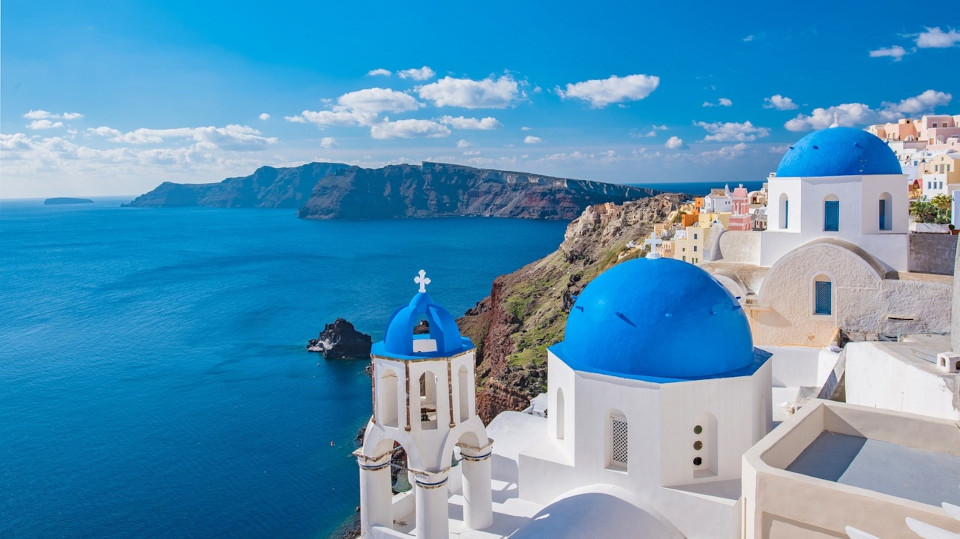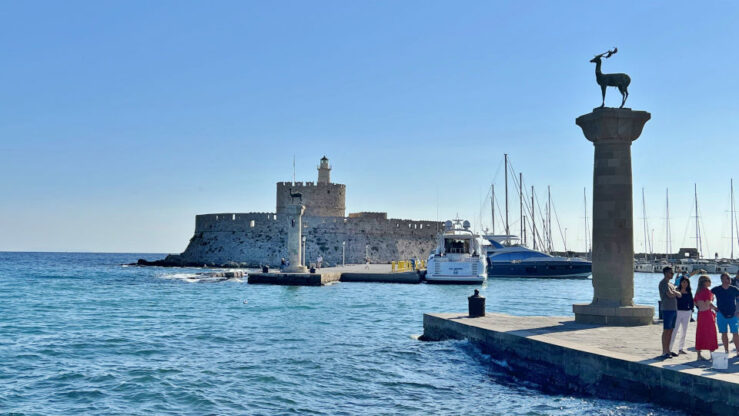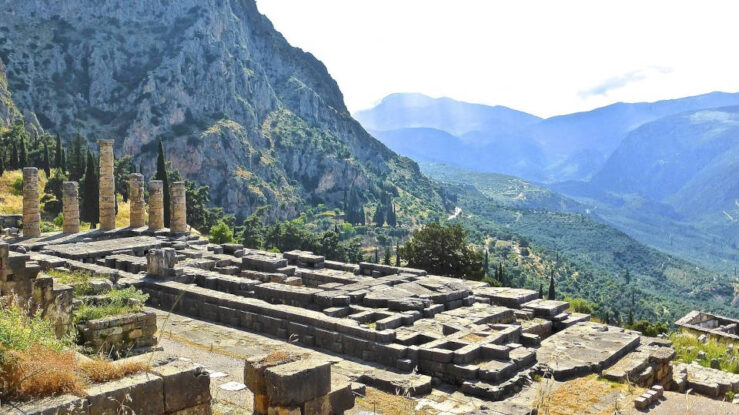Things to Do in Santorini: Fira, Oía, Kamari, Akrotiri…
1. Creation and ancient history
2. Fira
3. Imerovigli
4. Oia
5. Akrotiri
6. Kamari
7. Pyrgos
8. Excursions
The spectacular archipelago features an active volcanic island, Néa Kaméni, in the centre of the caldera, located next to the old Palía Kaméni. Visitors come to Santorini from near and far to visit the enticing island appearing on a large proportion of the postcards sold throughout Greece – either flying in or visiting during a cruise as part of the cruise itinerary. The cruise ships line up in the caldera while the passengers explore the whitewashed villages Fira/Thíra, Oia, and Imerovigli on the caldera rim, as well as the ancient settlement Akrotiri, discover the island wine culture, enjoy Kamari Beach, and marvel at the volcanic geology.
In addition to the villages overlooking the caldera and the active underwater volcano in the middle, Santorini features awesome volcanic beaches, both black and red. If you want to enjoy the island’s volcanic black beaches and clear waters, Kamari, on the eastern side of Santorini, is an excellent place to stay for a few days. Kamari’s Black Sand Beach is a product of the volcano eruption that occurred in 1600 BC and covered the island in ash, pumice, and volcanic lava. From there, you can easily visit Pyrgos, the gorgeous hilltop village visible from afar.
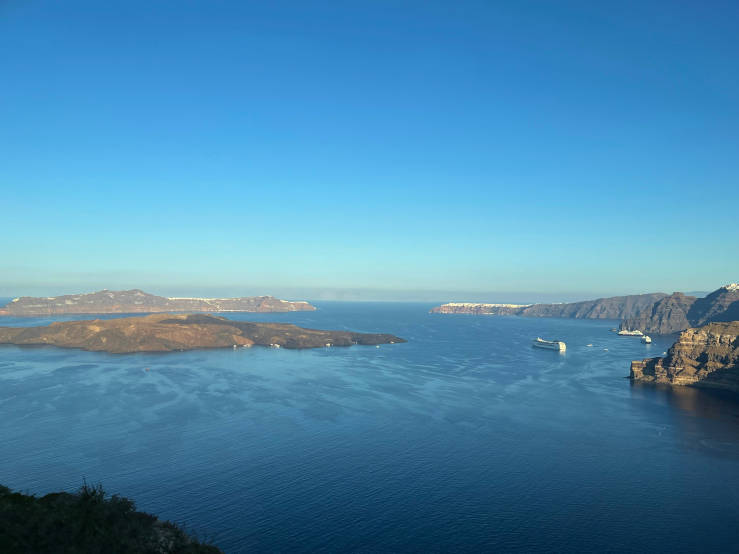
Photo: Travel In Culture
Santorini, also known as Thíra / Thera, is the spectacular southernmost island of the archipelago belonging to the Cyclades in the Aegean Sea, created 3,600 years ago in a gigantic volcanic eruption, one of the largest ever recorded. That resulted in the island ‘exploding’ and creating the impressive caldera which characterises the archipelago today. In addition to Santorini, the archipelago consists of the inhabited island Therasia/Thirasía, as well as several uninhabited islands, the active volcanic islets Néa Kaméni and Palaía Kaméni, and Aspronísi.
The first settlements in Santorini took place in antiquity, around 2000 BC. The Minoans had a highly developed society and established a flourishing culture at Akrotiri on the southern tip of Santorini.
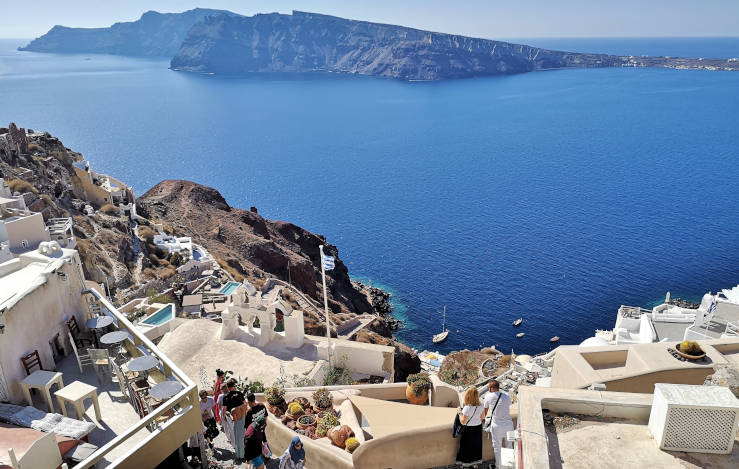
Photo: Travel In Culture
Tragically, the powerful Thera eruption 3,600 years ago put an end to the Minoan civilisation at Akrotiri in Santorini and obliterated the civilisation in Crete at the height of the Minoan culture. Due to the eruption, a gigantic tsunami was created, a tsunami that was so potent that it wiped out the people as far away as Crete, including those who tried to escape from Santorini to Crete.
The volcanic explosion and annihilation of the ancient culture in Santorini have been linked to the sinking of the legendary city Atlantis. The volcanic activity has existed around Thera for 2 million years, and the volcanic centre here is today the most active in the South Aegean Volcanic Arc.
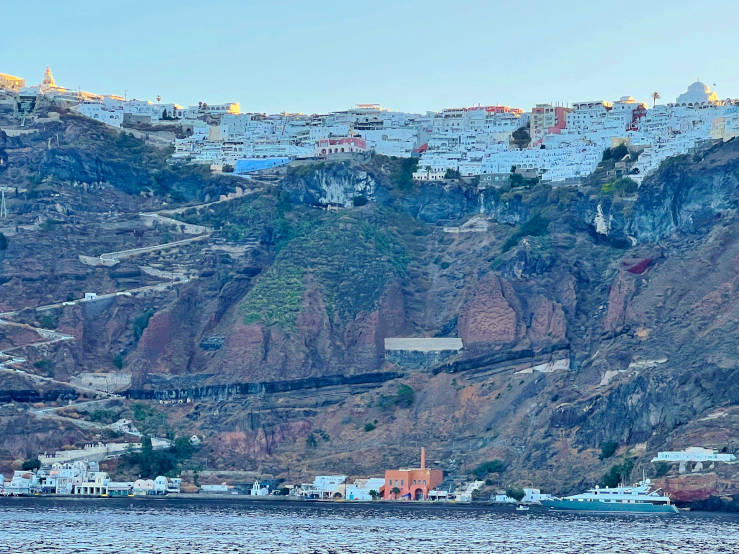
Photo: Travel In Culture
Fira (or Thíra) is the island capital, overlooking the hundreds of metres deep lagoon, the two volcanic islands in the middle of the archipelago, and the cruise ships at anchor as passengers explore Santorini.
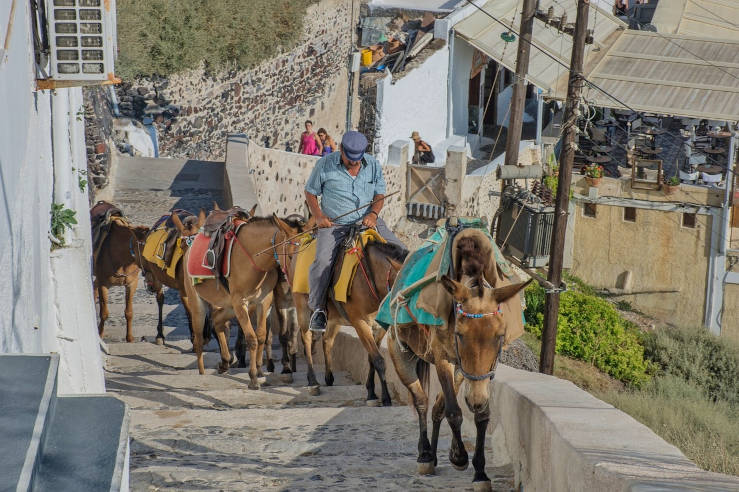
Photo: hjrivas / Pixabay
The capital can be reached by motorboat from the cruise ships – either directly to the foot of Fira – or to the harbour Órmos Athiniós, from where waiting buses take passengers to Fira or sightseeing around the island. When arriving at Fira’s harbour, you will either take the cable car up to Fira or hike up the winding road where there is still the alternative option to go by donkey or horse!
It is a beautiful town with a wealth of gift shops, bars, restaurants, accommodation options, and a vibrant nightlife. Wherever you look, you will have the most panoramic views of the caldera and the surrounding seascape.
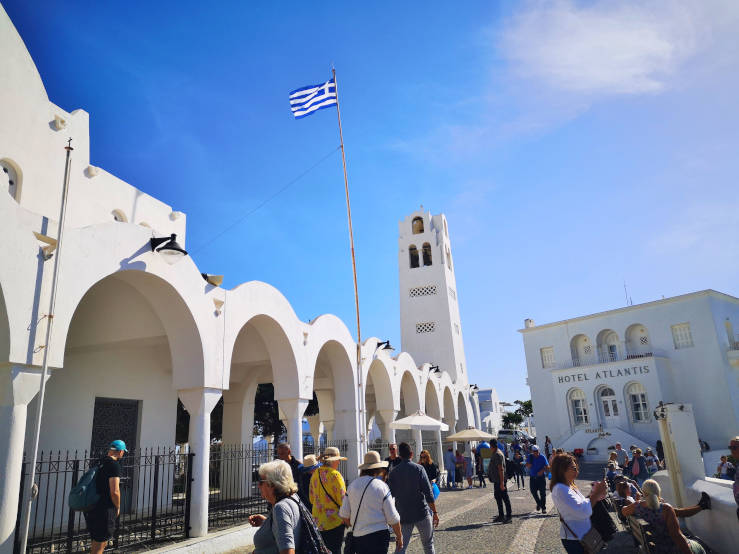
Photo: Travel In Culture
Moreover, there are two fantastic museums in Fira: The Archaeological Museum of Thera and the Museum of Prehistoric Thera – each providing insight into Santorini’s fascinating past in their way.
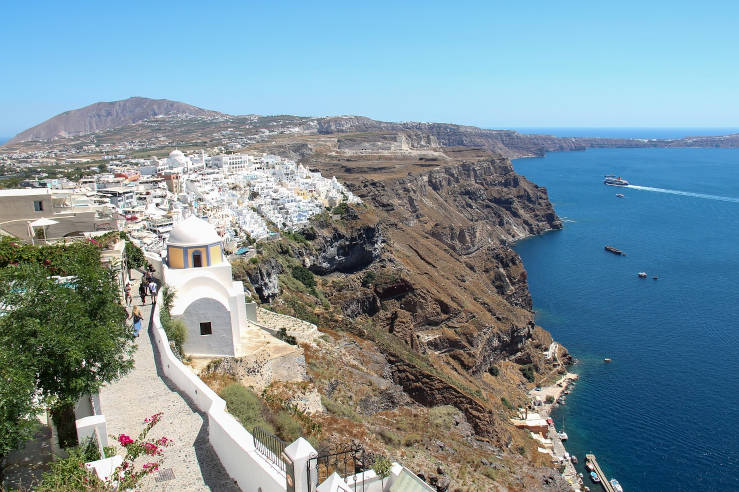
Photo: Pat / Pixabay
Imerovigli is one of the loveliest villages in Santorini, built on the highest point of the cliffs along the caldera – just a few kilometres north of Fira. The village is about 300 metres above the sea. From up here, there is the most breathtaking view of the lagoon and the caldera rim. Like in Oia, even further north, people flock to Imerovigli to admire the fiery Santorini sunset.
The village has everything you could need: tranquillity, picture-postcard-whitewashed houses that are stunningly beautiful against the blue sky and sea, charming tavernas and local shops, and pretty little churches and chapels. The views are breathtaking, and you will find several amazing lookouts along the way if you hike up to Imerovigli from Fira, including the Skaros Rock.
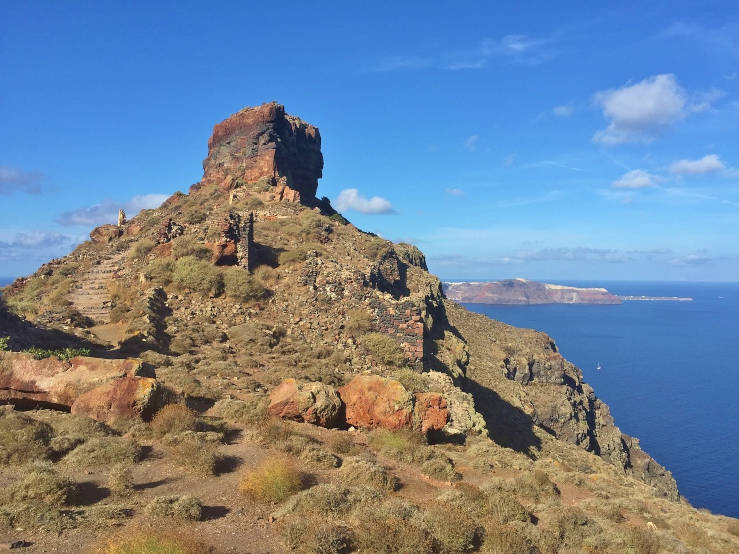
Skaros Rock at Imerovigli | Photo: Teamgardnerracing / Pixabay
If you are looking for extraordinary accommodation options, families and places rent out their ‘cave apartments’. That means you can stay in a cave ‘dug’ into the cliffs. From the terrace, you will enter the living room, the kitchen, and the bedroom, and then, perhaps deep inside the cave, you will find the (humid) bathroom! That is a cool experience!
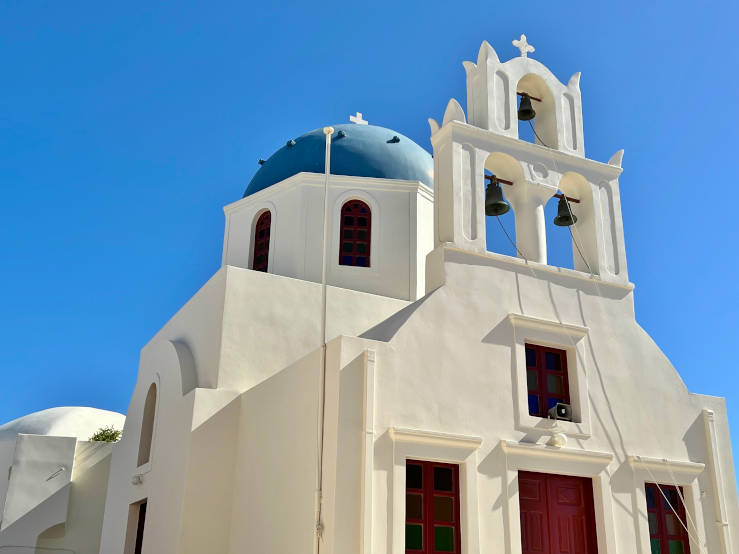
Photo: Travel In Culture
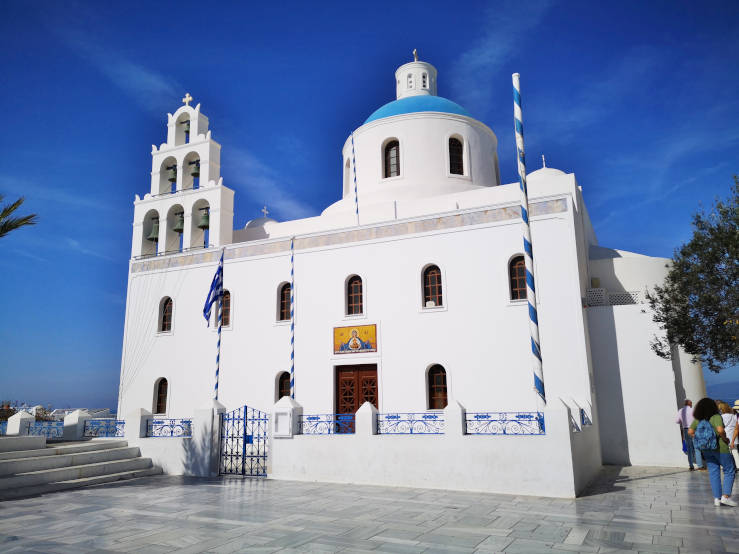
Photo: Travel In Culture
Oia, or Oía in Greek, is the epitome of a scenic Santorini village, built into the steeply sloping caldera cliffs, where terraces and cave houses have been carved into the mountainside. The building style is traditional Cycladic, and the white houses are complemented by classical blue-domed churches and turquoise swimming pools belonging to small hotels and private apartments.
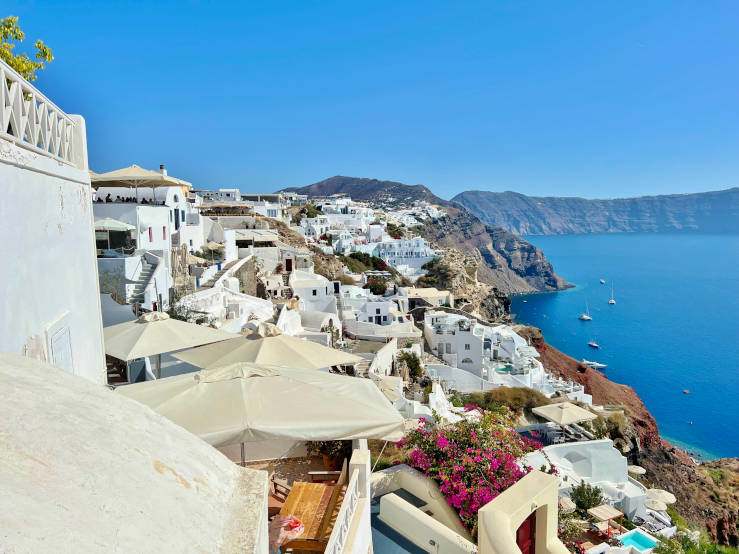
Photo: Travel In Culture
From viewpoints along the narrow alleys, it is possible to spot several neo-classical mansions constructed towards the end of the 19th century by Santorini’s ship captains. At that time, Oia was a mariners’ village with 130 sailing ships due to the significant trade of wine and other products through the Mediterranean with countries as far away as Russia and Alexandria. The harbour at the foot of the cliff, Arméni, even had its wharf.
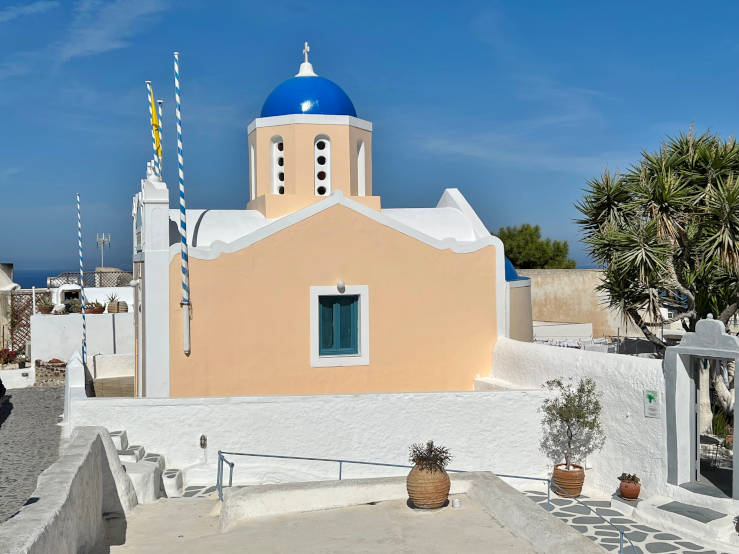
Photo: Travel In Culture
After a massive earthquake in 1956 with its epicentre near the village, many residents left Oia. Since then, the caldera village developed into a pronounced tourist destination in Santorini with expensive hotels and exquisite restaurants. Visitors arrive to see the whitewashed skyline, the blue cupolas, and the beautiful sunset.
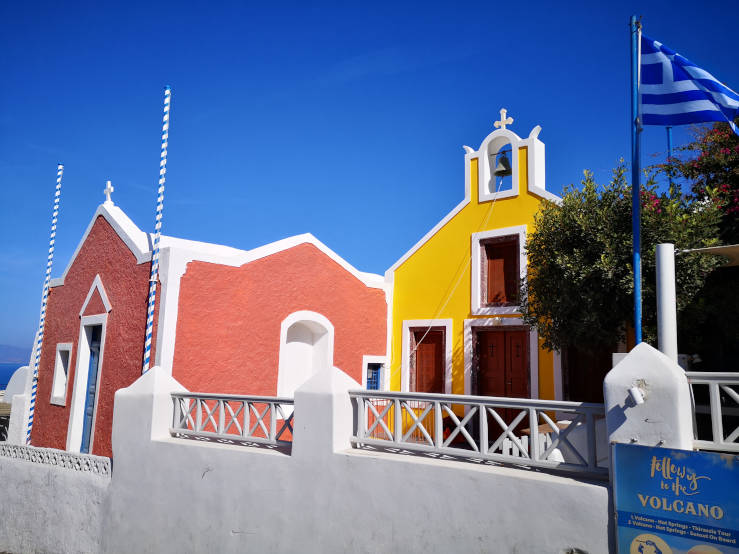
Photo: Travel In Culture
Akrotiri is the site of the ancient Minoan settlements in Santorini, which began in 2000 BC.
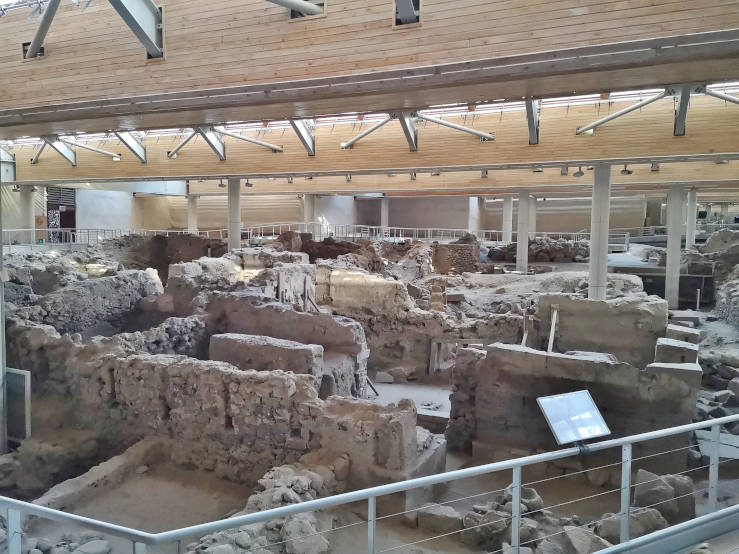
Photo: Travel In Culture
Despite being a highly developed society, their heyday was relatively short since a major volcanic eruption occurred approximately 400 years later, completely crushing the city of Akrotiri. The Minoan civilisation was sadly buried under volcanic debris and forgotten for thousands of years.
In the middle of the 19th century, the first signs of an earlier settlement appeared here again.
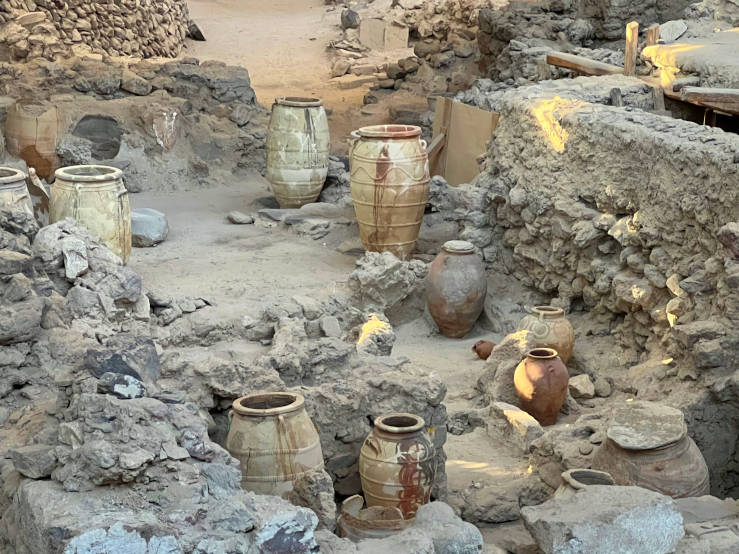
Photo: Travel In Culture
However, it was not until 1967 that a more systematic approach was taken by Professor Spyridon Marinatos from the Archaeological Society in Athens. He wanted to uncover the ancient civilisation and verify the theory that the Thera eruption completely wiped out the Minoan culture.
Over the last few decades, well-preserved ruins from ancient Akrotiri have been excavated – and excavations continue in the area. Most likely, hundreds of ancient house constructions remain to be rediscovered, including valuable artefacts related to an exceptionally rich and highly developed society.
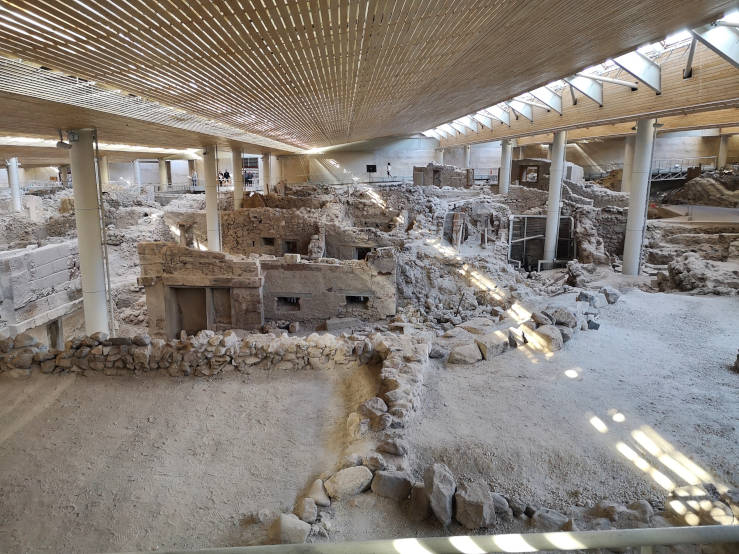
Photo: Travel In Culture
When visiting the site, you will be surprised by the infrastructure uncovered. Many of the houses are three-storey houses, there are streets, squares, a mill house, shops, vessels, furniture, drainage systems, water closets, and signs of using both hot and cold water through different pipe systems. The hot water almost certainly came from the geothermal sources.
The Akrotiri civilisation was a prosperous society in Santorini with a thriving culture of fine artwork and pottery. Finds indicate that there was trade with Crete and other locations in Greece, Cyprus, Egypt, and Syria. Everything is surprisingly well-preserved under the thick layer of volcanic ash, including the beautifully painted amphoras, magnificent wall paintings and frescoes!
Kamari is a seaside village on the flat side of Santorini in stark contrast to the caldera villages. It is a modern village with shops, tavernas, and bars with live music, and it holds the island airport. Hotels and rooms are available in all price categories – from 5-star hotels to much more affordable rooms and studios. Overall, there are far more things to do in Kamari than at Perissa Beach, a bit further south on the same coast.
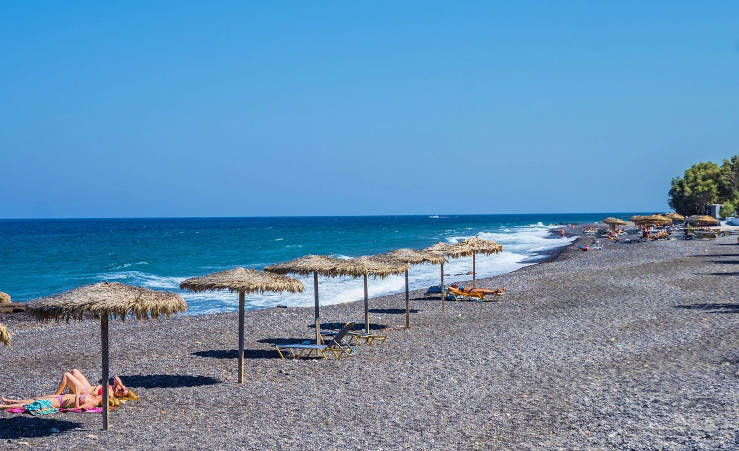
Photo: Michelle Raponi / Pixabay
Kamari Beach is the main attraction with its spectacular black sand and pebbles and crystal clear waters. If you are looking for a beach holiday in Santorini, Kamari is the perfect choice! From Kamari, you can travel to other villages and locations around the island, so you can easily combine a beach stay with cultural sightseeing in other parts of Santorini. Besides ancient archaeology, idyllic spots and geologically interesting phenomena, Santorini is also a winegrowing island – and you can visit a winery for wine tasting and gaining insight into the unique winegrowing methods here, just a few kilometres from Kamari.
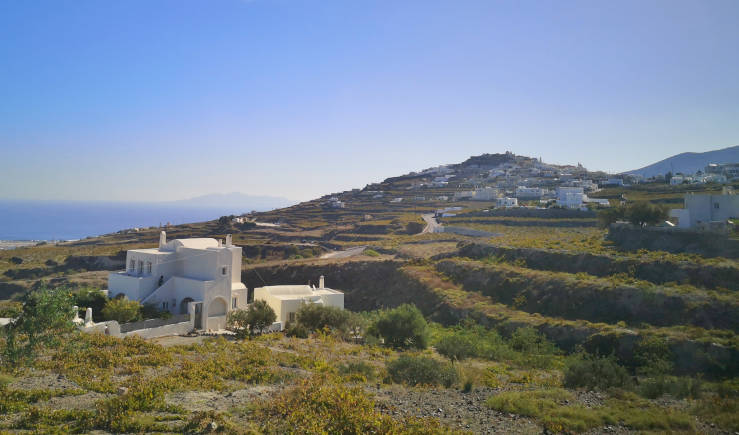
Pyrgos | Photo: Travel In Culture
The hilltop village Pyrgos is one of the real gems of Santorini, and it is worth considering a day trip or hike to the biggest preserved village on the island. Up there, it is as if you have entered a time warp, and life has stood still in Santorini. It is culturally more traditional than many of the more tourist-oriented villages and towns around the island that have developed to please visitors. Pyrgos has local authentic restaurants offering traditional meals, and if you are looking for a local stay in the surroundings of a bygone era, there are unique opportunities up here!
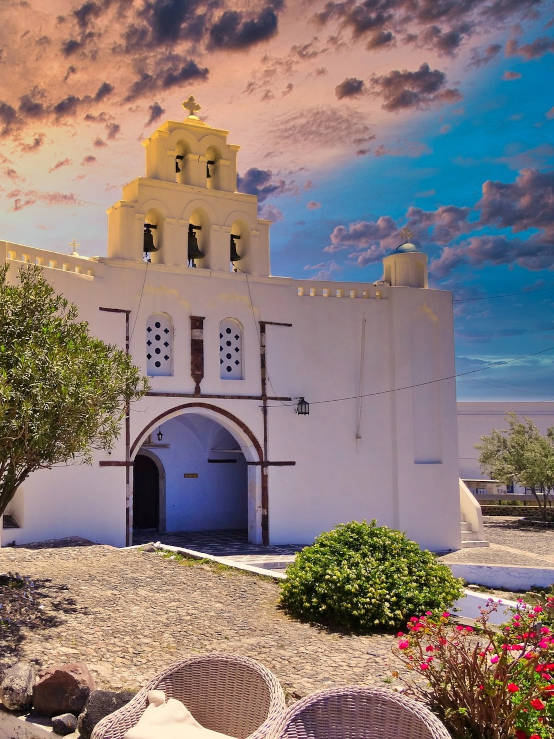
Pyrgos | Photo: Peter Wolf / Pixabay
In some way, to enter or ‘climb’ the village of Pyrgos is like entering a castle complex – which is also partly true, since you will find the 13th-century Pyrgos Kasteli, a Venetian castle, up here – which over the years developed from initially being just a simple monastery to its current extent. The fortress hamlet seems rather unified and integrated, and you get the impression that there are still strong ties between the villagers and that they share and value their common cultural heritage. The local cultural society organises and supports cultural events in Pyrgos, such as dance, theatre, and music.
In Pyrgos, you will spot numerous churches and chapels that are an integrated part of the village architecture. The Church of the Presentation of the Virgin Mary is one of the most important and largest churches in Santorini. It dates from 1660 and is still widely used by the Pyrgians. Another noteworthy church is the Church of Aghios Nikolaos, with a public square in front.
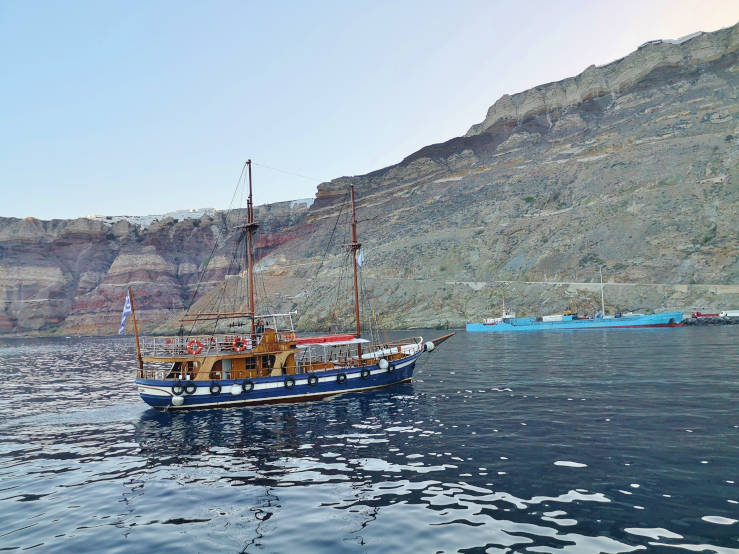
Photo: Travel In Culture
Whether you stay in Fira, Oia or Kamari, there are plenty of opportunities for excursions around Santorini – including the other islands in the archipelago.
Some of the most obvious day trips include a trip to the Red Beach in the southern part of the island, as well as to the other inland village Emborio (in addition to Pyrgos), also featuring a Venetian castle, whitewashed houses, blue-domed churches and medieval alleys.
You can also take a tour to explore the active volcanic island Néa Kaméni and walk to its summit, or visit Palía Kaméni, where you can take a dip in the thermal water. Finally, the inhabited island Therasia/Thirasía is also an option if you are looking for an authentic, local experience.
Read next: Make a Road Trip in the Peloponnese and Exploring Ancient Corinth and the Corinth Canal
Things to Do in Santorini: Fira, Oia, Kamari, Akrotiri, Imerovigli, Pyrgos
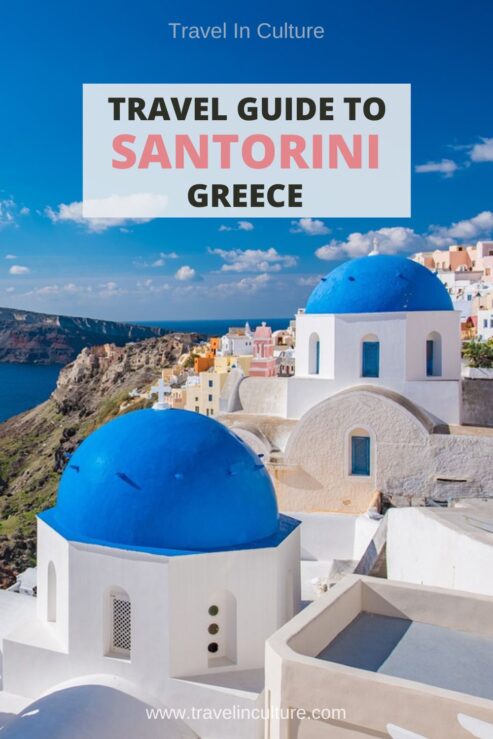
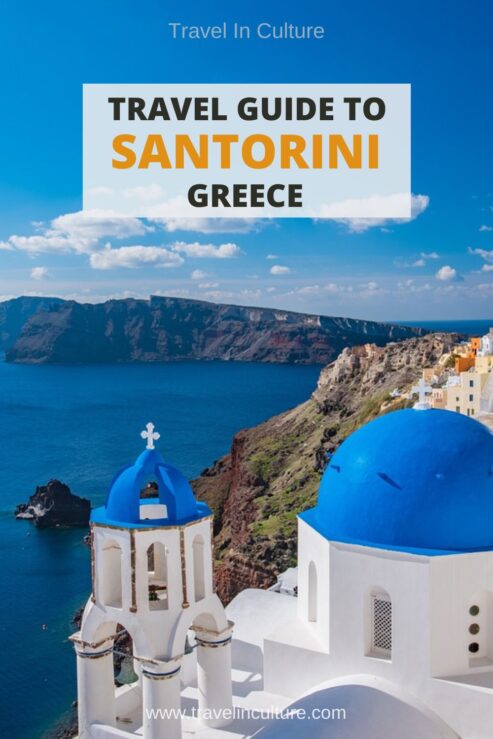
Featured image of
Things to Do in Santorini: Fira, Oia, Kamari, Akrotiri, Imerovigli, Pyrgos:
Russell Yan / Pixabay
Santorini: Fira, Oia, Kamari, Akrotiri, Pyrgos, Imerovigli


